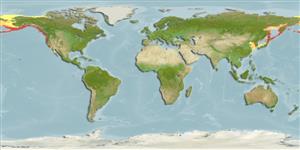Teleostei (teleosts) >
Perciformes/Zoarcoidei (Eelpouts and pricklebacks) >
Anarhichadidae (Wolffishes)
Etymology: Anarrhichthys: Greek, anarhichaomai = to climb up + Greek, ichthys = fish; ocellatus: ocellatus for the eye-like spots.
More on author: Ayres.
Environment: milieu / climate zone / depth range / distribution range
Ecology
Marine; demersal; depth range 1 - 226 m (Ref. 2850). Temperate; 80°N - 26°N, 117°E - 111°W (Ref. 57366)
North Pacific: Sea of Okhotsk and the Sea of Japan to the Krenitzen Islands, in the Aleutian chain and Imperial Beach, southern California, USA.
Size / Weight / Age
Maturity: Lm ? range ? - ? cm
Max length : 240 cm TL male/unsexed; (Ref. 4925); max. published weight: 18.4 kg (Ref. 27436)
Adults seek shelter among rocks in subtidal areas (Ref. 2850) and will occupy the same shelter until driven out by larger wolf-eels or a large octopus (Ref. 28499). Juveniles are pelagic for up to two years (Ref. 28499). Feed on hard-shelled invertebrates and fishes (Ref. 2850). Both male and female wrap their body around the egg mass to keep the eggs in place and to deter predators (Ref. 58332). Large specimens can inflict a painful bite (Ref. 28499). Its flesh is tasty (Ref. 28499).
When courting, the male wolf-eel butts his head against the female's abdomen, wraps around her, and fertilizes her eggs as she extrudes them. Eggs are laid and both male and female wrap themselves around the egg mass to protect it . Only one parent at a time leaves the eggs to feed. The female periodically rotates the eggs until they hatch. A male and female may pair for life (Ref. 28499).
Eschmeyer, W.N., E.S. Herald and H. Hammann, 1983. A field guide to Pacific coast fishes of North America. Boston (MA, USA): Houghton Mifflin Company. xii+336 p. (Ref. 2850)
IUCN Red List Status (Ref. 130435: Version 2024-1)
Threat to humans
Traumatogenic (Ref. 2850)
Human uses
Fisheries: minor commercial; aquarium: public aquariums
Tools
Special reports
Download XML
Internet sources
Estimates based on models
Preferred temperature (Ref.
123201): 1.2 - 10.5, mean 4.7 °C (based on 485 cells).
Phylogenetic diversity index (Ref.
82804): PD
50 = 1.0312 [Uniqueness, from 0.5 = low to 2.0 = high].
Bayesian length-weight: a=0.00398 (0.00177 - 0.00897), b=3.17 (2.97 - 3.37), in cm total length, based on LWR estimates for this (Sub)family-body shape (Ref.
93245).
Trophic level (Ref.
69278): 3.5 ±0.53 se; based on food items.
Resilience (Ref.
120179): Low, minimum population doubling time 4.5 - 14 years (tm=7; Fec=10,000).
Fishing Vulnerability (Ref.
59153): Very high vulnerability (90 of 100).
Nutrients (Ref.
124155): Calcium = 12.2 [6.7, 26.3] mg/100g; Iron = 0.23 [0.12, 0.46] mg/100g; Protein = 17.9 [15.8, 19.8] %; Omega3 = 0.307 [0.169, 0.537] g/100g; Selenium = 27.5 [14.0, 56.6] μg/100g; VitaminA = 5.19 [1.56, 17.30] μg/100g; Zinc = 0.393 [0.268, 0.590] mg/100g (wet weight);
